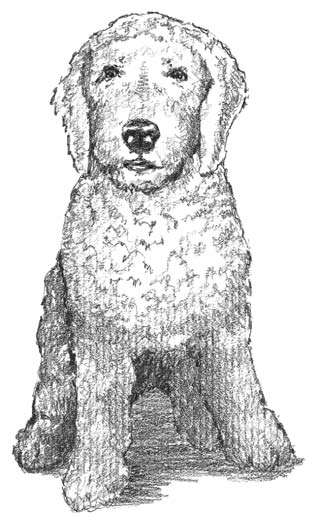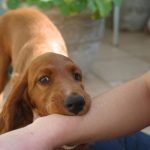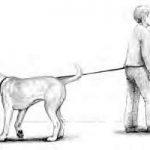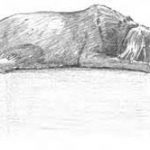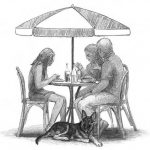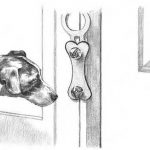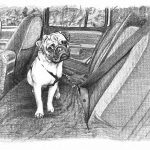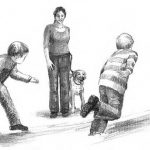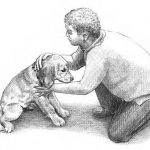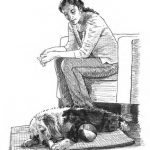- Knowing which dogs need to be clipped
- Choosing the right tools: Clippers, blades, and scissors
- Clipping your pooch
Clipping a dog is one of the more daunting tasks for pet owners. If you have a dog who needs to be clipped or one who needs a touch-up here or there, this chapter’s for you.
Several breeds need to be clipped. Most of these dogs have single coats, the kind without an undercoat. The hair of these dogs grows like yours and mine, and because these pooches don’t shed, they’re bound to look like a terrible mess of hair if you don’t clip their coats. Other breeds are clipped for show or style reasons, or maybe just because the pet owner doesn’t want to deal with all that hair.
Don’t fear the electric clippers. You can discover the basics of using them and what you can do with all those strange blades and plastic snap-on thingies in this chapter. You can also discover how to safely handle scissors (also called shears in the grooming world), and I even explain how to give your dog a basic clip.
After you gain a good grasp of the basics in this chapter, you can check out Part III, where I tell you about the specifics of grooming the different types of dog coats.
Deciding Whether to Clip Your Dog
Before I tell you about clipping your dog, you need to determine whether your dog actually needs to be clipped. Although many breeds need only a cursory neatening up, the following breeds generally need more serious clipping:
- American Cocker Spaniel
- American Water Spaniel
- Bedlington Terrier
- Bichon Frise
- Black Russian Terrier
- Bouvier de Flandres
- Brittany
- Cesky Terrier
- Cocker Spaniel (American and English)
- Curly-coated Retriever
- English Setter
| - English Springer Spaniel
- Field Spaniel
- Gordon Setter
- Irish Setter
- Irish Water Spaniel
- Kerry Blue Terrier
- Löwchen
- Poodle (all sizes)
- Portuguese Water Dog
- Soft Coated Wheaten Terrier
- Springer Spaniel
|
At first, you may be surprised that more breeds aren’t on this list, but that’s because some breeds aren’t exactly clipped breeds — they’re
stripped breeds, or dogs from whose coats you need to strip excess hair to attain the proper look. Most dog owners, however, aren’t into time-consuming stripping procedures (see Chapter
Tidying the Tresses of the Long-Haired Breeds), so they opt to use the clippers on their dogs instead. Nothing is wrong with using the clippers in that manner, but you won’t get the right look for your breed if you intend to show your dog (see Chapter
Going Pro: Starting a Dog Grooming Business).
Getting Acquainted with Your Tools
A dizzying array of electric clippers and blades are sold in the grooming-tool market these days. Open up a grooming catalog and you’ll see a bunch of different clippers ranging from the basic home-use, pet-grooming clippers to the fancy-schmancy ones the pros use. I’m sure that broad range has you asking, “What do I really need to clip my dog?”
Clip, clip! Deciding which clippers to buy
The kind of clippers you need depends on how much clipping needs to be done with your particular dog. Here are three hints that can help you choose wisely:
– If you’re using clippers just to neaten up Fido’s feet or clean up a stray hair here or there, you’re likely to need only a set of inexpensive home clippers that won’t see a lot of use.
– If you want to maintain a nice show coat (or even a good pet coat) between trips to the groomer, you’re probably looking at medium-priced clippers with which you can use a variety of blades, depending on your dog’s needs.
– If you want to trim and style your own dog and perhaps other dogs, you’re looking at getting professional-style clippers, maybe with more than one speed and certainly with more than a few blades. Some of these clippers also are cordless, so you don’t always have to have an outlet handy.
Depending on how much work you have on hand, the type of clippers, and the speed at which you do your clipping, you may run out of battery power partway through your clipping job when using cordless clippers. Keep that in mind when you consider cordless clippers.
Several different manufacturers make clippers, including Oster, Wahl, Andis, and Conair, among others. Oster is pretty much the leader when it comes to clippers, and its blades are universal enough that other manufacturers make their clippers so that Oster-style blades fit them. In fact, almost all clipper blades are made to fit Oster or similar products.
Tip
If you decide to purchase a clipper other than an Oster, make sure that it’s equipped to use Oster-style blades. Most clippers are, but you need to be sure; otherwise, you’re stuck buying proprietary blades that may cost more. Besides, if your clipper breaks, you’re forced to choose between buying new clippers of a brand that matches the blades you already have or tossing everything and starting from scratch.
Becoming a blade-runner
Most clippers come with blades, but some don’t. These blades are typically marked either by the closeness of the cut or by their Oster number (size 10, for example).
Remember
You can tell how close an Oster blade cuts by the size of the number. The higher the number, the closer or finer the cut. The lower the number, the more hair you’ll have on your dog after each clipping. So a size 40 blade (surgical cut) produces a much finer cut than a size 5 blade (1⁄4-inch cut).
Choosing your blades is a bit of an art form and depends on your dog’s breed and coat type. Look at your breed standard, talk to other owners of your breed, and check out Part III of this book to determine what kind of blades are best for your dog’s coat. Table 7-1 describes what blades are out there and what they’re used for.
Most blades are full-toothed, but you can also find some skip-tooth blades. Skip tooth blades are for stand up coats (Poodle type coats). Full-tooth blades are for smooth or drop-coated dogs (Spaniel type coats).
Table 7-1 Clipper Blade Types, Cuts, and Uses |
Blade Size | Cut Length/Type | Uses |
40 | 1⁄100-inch/surgical | Trimming hair from around wounds; can be used for ears and face as well |
30 | 1⁄50-inch/very close | Show clips |
15 | 3⁄64-inch/medium | General use; this blade is also referred to as a Poodle blade |
10 | 1⁄16-inch/medium | General use, including trimming hair from around and between your dog’s paw pads |
9 | 5⁄64-inch/medium | Smooth finish, general use |
81⁄2 | 7⁄64-inch/medium | General use; this blade is also referred to as a Terrier blade |
7F | 1⁄8-inch | Full tooth, body clipping |
7 | 1⁄8-inch | Skip tooth, body clipping |
5F | 1⁄4-inch | Full tooth, body clipping |
5 | 1⁄4-inch | Skip tooth, body clipping |
4F | 3⁄8-inch | Full tooth, body clipping |
4 | 3⁄8-inch | Skip tooth, body clipping |
3F | 1⁄2-inch | Full tooth, body clipping |
3 | 1⁄2-inch | Skip tooth, body clipping |
5⁄8 | 1⁄32–5⁄8-inch/wide | For trimming and finishing |
7⁄8 | 1⁄32–7⁄8-inch/wide | For trimming and finishing |
Snapping on guide combs
Snap-on guide combs (shown in Figure 7-1 along with electric clippers, blade
lubricating oil, and a cleaning brush) are plastic combs that you attach to
your electric clippers to provide an even cut. So if you get a half-inch guide
comb, you’ll get a half-inch cut. Pretty simple, isn’t it?
Some guide combs come with the clippers. Others you’ll have to buy separately.
Figure 7-1: Electric clippers (with oil and a cleaning brush) and guide combs help maintain your pooch’s coat.
Using scissors
When you just can’t get your dog’s coat to even out with clippers, no matter how hard you try, use scissors or shears (a fancy name for scissors), but do so only with extreme caution. Scissors can injure you and your dog if you’re not careful.
You can find plenty of reasons for using scissors on your dog’s coat. One is that you just don’t have the same control with clippers that you do using scissors. If you need to trim whiskers or stray hairs from your dog, for example, scissors probably are better than clippers. Scissors are best used on dogs who are already groomed properly and just need touch-ups. Here are some tips about using scissors:
- Choose scissors that are sharp and made for dogs.
- Never use dull scissors on a dog’s coat.
- Go slowly when using the scissors.
- Always keep your fingers between the scissors and your dog’s skin. Otherwise, mishaps that require you to take your dog to the emergency vet can happen easily.
- Train your dog to stay still when you’re using scissors (see Chapter Mastering Brushing and Bathing Basics). Otherwise, you can accidentally hurt him.
- Avoid distractions when using scissors. That means no TV, no chatty friends, and no talk radio. Remember, you’re working closely with your dog’s coat using sharp instruments.
Technical Stuff
Thinning scissors (also called thinning shears) are used to thin the coat or blend in one layer of hair with another. The scissors have rows of skipped teeth that cut only every other hair. Like all scissors, thinning scissors can be dangerous if used incorrectly or without care, so use caution when handling and using them.
Getting Down to Clipping Business
Before you cut your first dog hair, make sure you treat your dog safely and plan how you’re going to clip her. Your dog needs to be clean and have all mats and tangles brushed out of her coat before you start clipping. Doing so makes clipping the coat evenly easier for you.
Preparing for success
You have your clippers and your dog. Now, what do you do to keep from running afoul while using the clippers? Here are some handy tips for getting your dog used to the clippers and keeping your dog looking good:
– Start clipping your dog as early as possible, even as a puppy. Getting an older dog used to the clippers is much harder than training a puppy to accept them.
Using quieter clippers can be helpful. Loud buzzing would scare me, too!
– Read your dog’s breed standard. Often, you can get clues about how your dog’s coat should look and how to make it look that way.
– Check out the breed club’s Web site for tips on how club members clip their dogs. Some breed clubs provide free guidelines on how their dogs should look.
– Have a professional groomer or a breeder show you how your dog’s coat needs to be clipped. Most groomers and breeders are happy to spend a little time helping you get it right.
If you make a mistake, don’t fret. Your dog may have a bad hair day, but it’ll eventually grow out. The main thing to be concerned with is using your clippers safely.
Using clippers safely
Here are some handy guidelines for safely using clippers on your dog’s coat:
– Be sure your clipper blades are sharp. Dull clippers pull hair more.
– Choose the clipper blade that works best with the specific type of coat your dog has so you achieve the result you want.
If you’re not sure about the cut of the blade you’re using, you can try using one of the many snap-on guide combs that are available. These combs help you make a uniform cut.
Warning!
– Always use clipper coolant or lubricant on your blades to keep them from getting too warm and burning your dog. Coolant or lubricant is available separately through pet supply catalogs and on the Internet. Clipper blades can become extremely hot, especially when you use them for a long time. If you burn your dog, she won’t soon forget, and I guarantee she’ll decide that clippers are no fun. Make sure that you wipe off any excess lubricant, or you’ll end up getting oil all over that nice clean coat.
Tip
Frequently turn your clippers off and touch them to make sure they’re not too hot. If they become too warm, simply spray on the coolant. It’s made especially for cooling down hot clippers. (Follow the directions on the canister.) When the clippers become too warm, you can also
- Switch blades and let the hot ones cool down.
- Switch to another clipper (if you have one).
- Place the blade on a metal surface, which quickly cools it off (a cookie or baking sheet works).
Making your first clip
The best way to find out how to use your clippers is to start by neatening up areas where your dog already has been trimmed but where the fur has grown a little untidy.
Before jumping into the deep fur, however, make sure that you’ve chosen the clipper size that works best for your dog’s coat and the right blade, and make sure that your dog is clean and free of tangles and mats.
Hold the clippers in a way that feels comfortable in your hand and gives you the most control over the clippers. Check out Figure 7-2 to get a better idea.
Figure 7-2: Clipping a dog can be daunting, but after you and your dog get comfortable with the clippers, it can be downright fun.
By starting with an inconspicuous area that needs some neatening up, you can easily find out how much hair your clipper and blade take off. If the amount of hair you removed is too much or too little, you can adjust by switching to a more appropriate blade. Remember: The higher the number of the blade, the shorter and finer the cut.
Remember
Always appraise your work as your clipping progresses — after you’ve trimmed a bit. That way, you know whether you’re taking off too much or too little. Don’t forget, however, that taking off too little is better than taking off too much. After all, you can always trim more off, but you can’t glue it back on.
And don’t forget to trim the hair that sticks out around and between your dog’s paw pads if you like a neater look. Simply use an electric clipper with a size 10 blade and hold the foot in its normal shape (not splayed). Trim the hair that sticks out beyond the pads (don’t clip the hair down between the pads), and then use the clippers to trim any other hair around the foot that ruins a neat presentation.
Attempting a Pet cut
Unless you’re set on your dog’s having a show cut (usually because you’re showing your dog), sometimes the best thing to do is to clip your dog in an easy-to-maintain cut. Often called a Puppy cut, a Teddy Bear cut, or Pet cut, this cut doesn’t require much work (see Figure 7-3). Follow these steps for giving your pooch a Pet cut:
1. Equip your clippers with a size 30 or 40 blade and an appropriate snap-on guide comb to set the length at which you want to clip your dog’s coat.
2. Go over your dog’s body with the clippers, trimming her coat to an even length.
3. Remove the snap-on guide comb, and gently trim the ears with either a size 10 blade or size 15 blade (if you want a closer shave).
Trim to the ear flaps, thus following the line of the ear.
4. Using the size 10 or size 15 blade without the snap-on guide comb, gently trim your dog’s underside — especially around the genitals and anus, to keep them clean.
Figure 7-3: Most owners like the simplicity of a Pet cut, because keeping it looking good doesn’t take too much effort.
Oops! Righting a wrong
Everyone makes mistakes. It’s a normal part of being human. Occasionally, you’re going to make goof-ups that aren’t going to hurt your dog but will make her look pretty silly. No matter how hard you try, you make a mess, and now your dog looks like she’s having a bad hair day. What do you do?
Take a deep breath before you panic, and try to relax. If your dog is injured, with cuts to the skin, see Chapter
It’s Showtime! Grooming a Dog for the Ring on how to handle them. If your dog has suffered clipper burn, you can use a little aloe vera on the burn, and remember to keep your clippers cool next time.
If, on the other hand, your dog has not been injured, remember that the mess you’ve made is only hair, and hair does grow back. You just need to figure out how to fix the problem so your dog won’t be the laughingstock at the dog park.
Assess the problem first. What did you do that looks so awful? In most cases, you’re probably looking at an uneven spot or two, so check to see whether there’s any way to blend the two layers of hair together. Thinning scissors (or shears — see the “Using scissors” section earlier in this chapter and Chapter
Training Your Dog for Grooming) can sometimes fix a problem; sometimes they can’t. Sometimes you can trim the area around the uneven spot to match, or vice versa. Your dog’s coat may be a little short for a while, and she may have to wear a sweater, but what the heck?
Tip
If you’re afraid you’re going to end up with a bald dog, put away all your grooming tools, take your dog off the table, and have a cup of coffee (or tea). After you’ve relaxed, evaluate your dog. Is this something you can realistically fix? Or do you need to call in the pros? Try not to clip your dog’s coat to the point where the only thing a pro can do is shave her.
by Margaret H.Bonham
